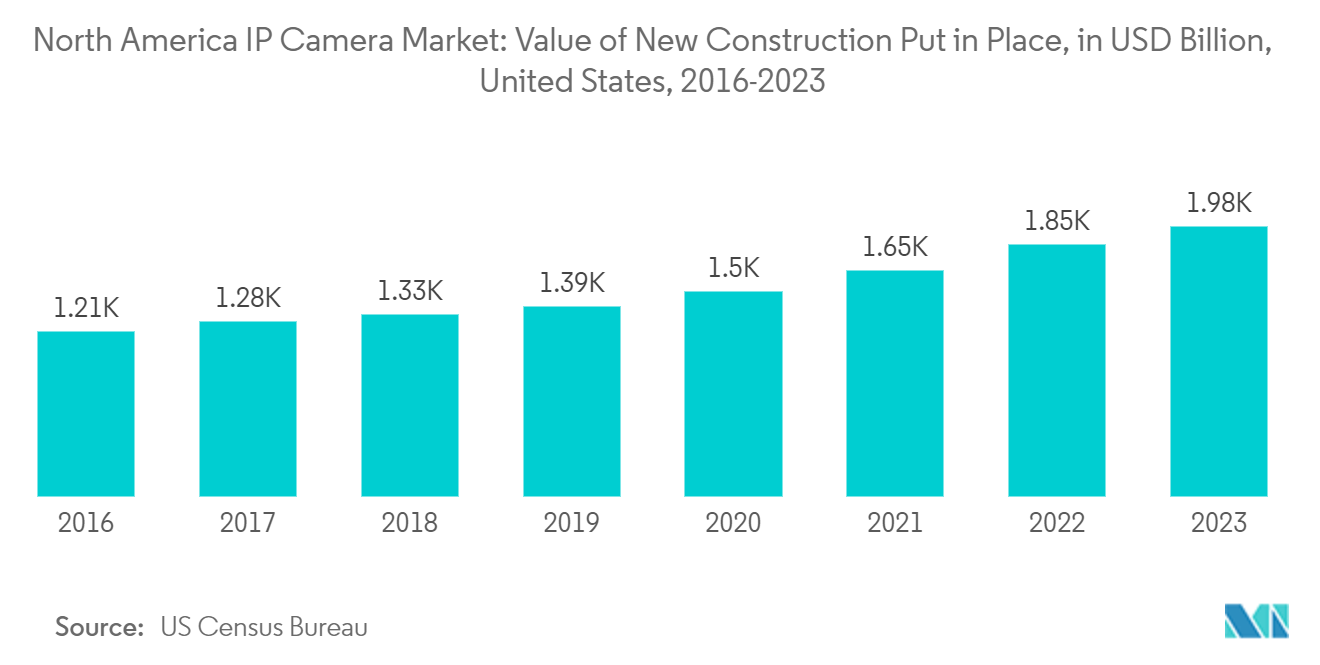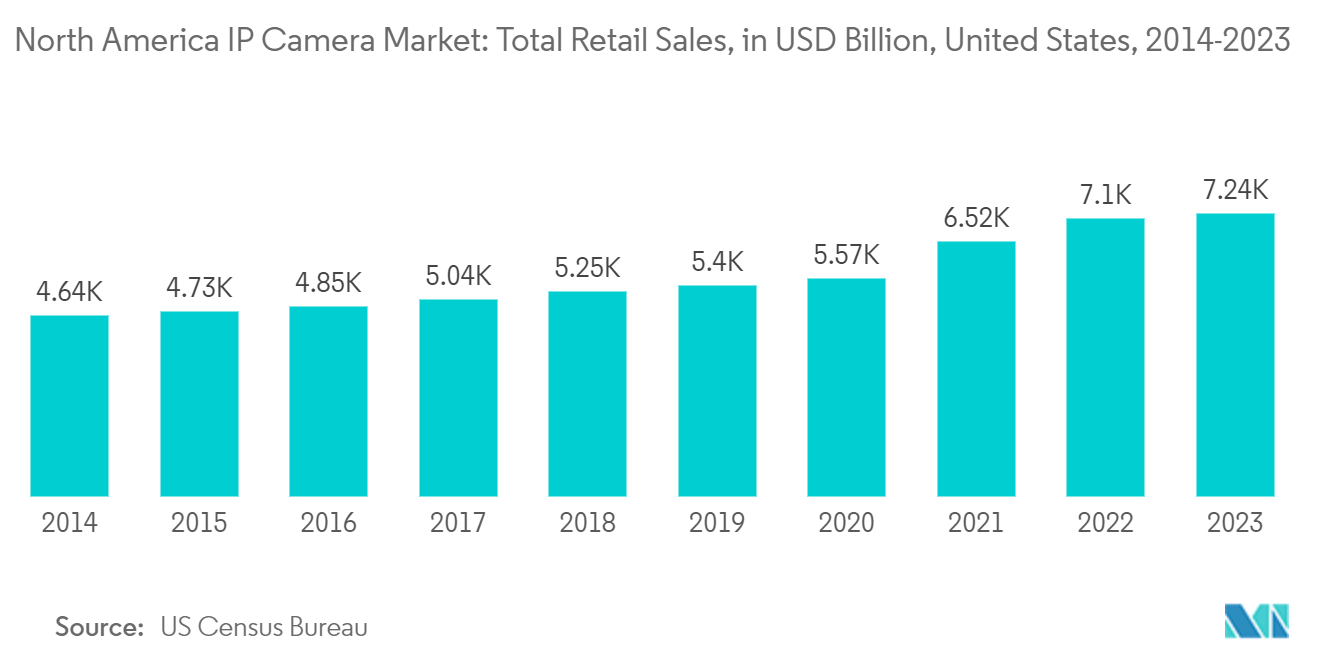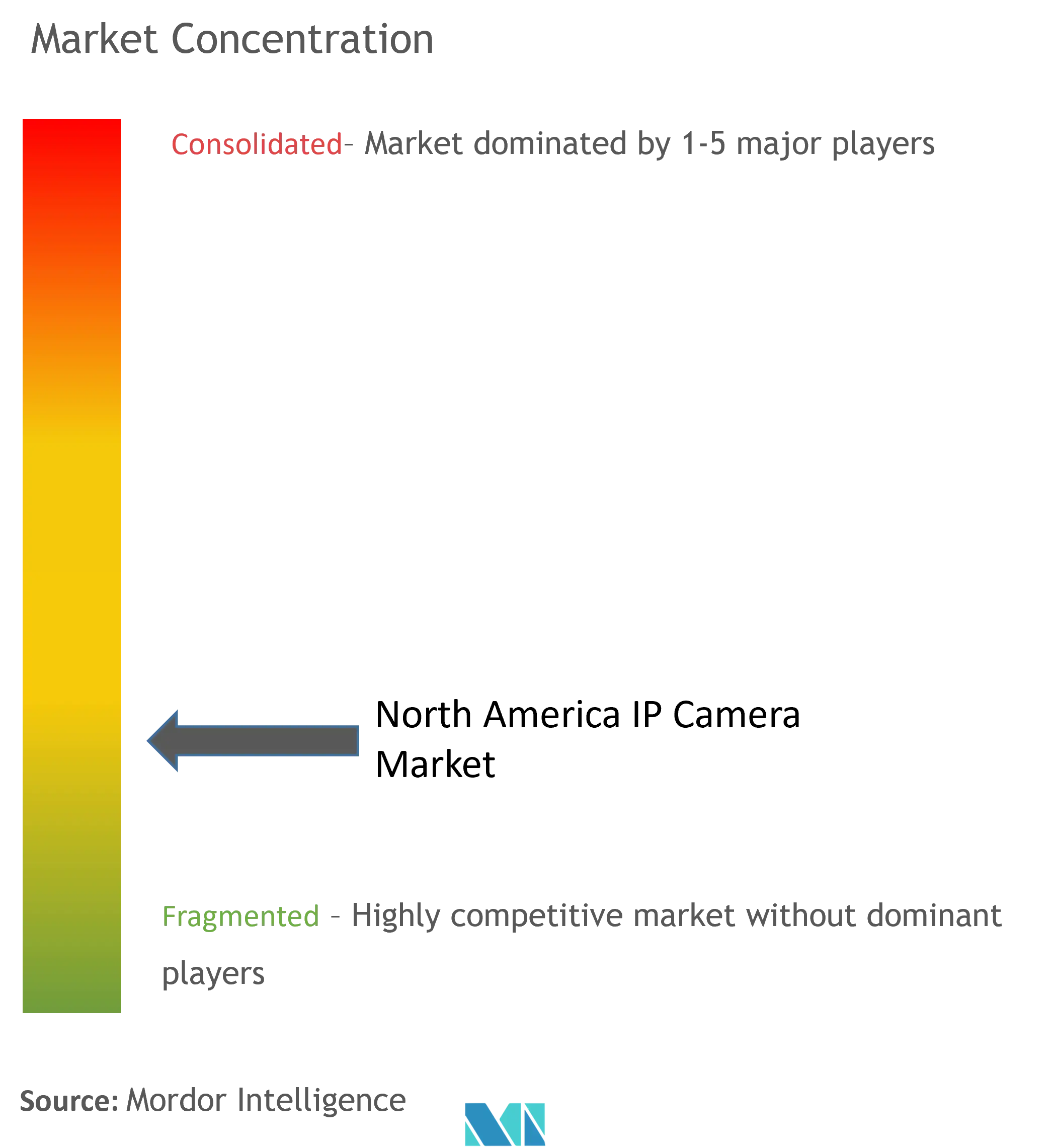North America IP Camera Market Size

| Study Period | 2018 - 2029 |
| Base Year For Estimation | 2023 |
| Market Size (2024) | USD 3.9 Billion |
| Market Size (2029) | USD 7.54 Billion |
| CAGR (2024 - 2029) | 14.10 % |
| Market Concentration | Low |
Major Players
*Disclaimer: Major Players sorted in no particular order |
North America IP Camera Market Analysis
The North America IP Camera Market size is estimated at USD 3.9 billion in 2024, and is expected to reach USD 7.54 billion by 2029, growing at a CAGR of 14.10% during the forecast period (2024-2029).
- IP cameras, or internet protocol cameras, are digital security cameras that receive and send video footage via an IP network. Unlike analog closed-circuit television cameras, IP cameras do not need a local recording device, only a local network. The IP cameras are equipped with a processing chip that compresses the video footage as it is recorded. The higher the camera resolution, the more data each video recording contains, which requires more storage space and bandwidth for transmission.
- IP cameras have evolved from conventional analog cameras to digital cameras that transmit video data over an IP network. These cameras offer superior image quality, higher resolution, and advanced features like facial recognition and video analytics. Technological advancements have improved IP cameras' performance and made them more affordable & accessible to a wider consumer base in North America.
- IP cameras often incorporate advanced video analytics capabilities, such as motion detection, object tracking, and facial recognition. These intelligent features enhance the effectiveness of surveillance systems by automatically alerting operators to suspicious activities or events. Video analytics also enable efficient post-event analysis, helping in investigations and evidence collection.
- The rise of IoT applications has further fueled the adoption of IP cameras. With the increasing interconnectivity between devices and the growing popularity of smart homes and smart cities, IP cameras play a critical role in enhancing security and providing real-time monitoring. IP cameras can be seamlessly integrated with other IoT devices, like motion sensors and alarms, creating a comprehensive surveillance ecosystem. This integration allows for automated responses to events, such as triggering alarms or sending notifications to authorized personnel, enhancing overall security and efficiency.
- The integration of AI in IP cameras is expected to augment the demand for the studied market. To that extent, in May 2023, CHeKT launched a new line of AI IP cameras that feature advanced AI tracking algorithms, a rich library of detection behaviors, which is claimed to offer deep learning features that facilitate the cameras to learn and identify the objects detected and offer true human & vehicle type identification, to remove any false objects that might trigger detections.
- However, the lack of interoperability between different camera brands and software platforms poses a significant restraint to the growth of the studied market. This limits the flexibility and scalability of IP camera systems, making it difficult for customers to integrate cameras from different manufacturers.
- Further, the initial cost of IP camera systems, including cameras, storage devices, and network infrastructure, can be prohibitive for small and medium-sized businesses. Additionally, the ongoing costs associated with maintaining and upgrading these systems can burden businesses with limited budgets. The high cost of IP camera systems often leads businesses to opt for traditional analog camera systems, which are more affordable but lack the advanced features and capabilities of IP cameras.
- • Income levels, demographic changes, and cultural preferences can also impact the demand for IP cameras. According to the International Monetary Fund (IMF), the gross domestic product (GDP) of the United States increased from USD 33.58 trillion in 2022 to USD 34.95 trillion in 2023. The robust economy of the United States is likely to aid the development of the studied market.
North America IP Camera Market Trends
The PTZ Segment is Expected to Drive the Market's Growth
• PTZ (Pan-Tilt-Zoom) IP cameras have gained significant popularity in North America due to their advanced features and capabilities. PTZ IP cameras offer pan, tilt, and zoom functionalities, allowing for a wide coverage area. These cameras can be remotely controlled, enabling users to adjust the viewing angle, zoom in on specific areas, and track moving objects or individuals. These cameras are designed to capture high-resolution video footage, ensuring clear and detailed images. This feature is crucial for accurate identification and evidence gathering in surveillance scenarios.
• Further, advanced PTZ IP cameras come with intelligent tracking capabilities, enabling them to automatically follow moving objects or individuals. This feature enhances security and decreases the need for manual monitoring.
• Compared to traditional analog cameras, PTZ IP cameras are more cost-effective in the long run. They utilize existing network infrastructure, eliminating the need for separate cabling and reducing installation and maintenance costs.
• Moreover, PTZ IP cameras can be accessed and controlled remotely using a smartphone, computer, or tablet. This feature allows users to monitor their premises from anywhere, enhancing convenience and accessibility.
• PTZ IP cameras find applications in various industries, including commercial, residential, transportation, and government sectors. The versatility and adaptability of these cameras make them suitable for a wide range of surveillance needs, contributing to market growth. The increase in construction activities in the region is likely to aid the growth of the studied market. For instance, according to the US Census Bureau, the value of overall construction output in the United States increased from USD 1,848.7 billion in 2022 to USD 1,980 billion in 2023.

The United States is Expected to Witness a High Market Growth Rate
• With the increase in crime rates and security threats, there has been a growing demand for surveillance and monitoring systems in the United States. IP cameras provide enhanced security capabilities, enabling real-time monitoring and remote access from any location. The ability to integrate with other security systems, such as access control and alarm systems, further strengthens the security infrastructure. This increased emphasis on safety and security has fueled the adoption of IP cameras across various sectors, including residential, commercial, and public spaces.
• The expansion of the retail market is likely to boost the growth of the studied market. For instance, according to the US Census Bureau, by the end of 2023, total retail sales in the United States reached approximately USD 7.24 trillion, around a USD 1.5 billion increase from the year before.
• Further, the decreasing cost of IP cameras is anticipated to be a significant driver for the growth of the studied market in the United States. As technology matures and competition increases, the prices of IP cameras have become more affordable, making them a viable option for a wider range of customers. Additionally, IP cameras eliminate the need for expensive analog infrastructure, such as coaxial cables, DVRs, and multiplexers, resulting in business cost savings. The cost efficiency of IP cameras has made them an attractive alternative to traditional surveillance systems, boosting their market demand in the country.
• The emergence of cloud-based solutions has significantly boosted the IP camera market in the United States. Cloud storage and video management platforms provide cost-effective and scalable options for storing and managing video footage. Cloud-based solutions eliminate the requirement for on-site servers and storage devices, reducing infrastructure costs and simplifying system maintenance. The convenience of accessing video footage from any location and the ability to easily share data with authorized stakeholders have further driven the adoption of cloud-based IP camera solutions.
• Moreover, the integration of IP cameras with smart home systems is anticipated to be a prominent driver for the studied market in the residential sector in the United States. IP cameras can be seamlessly integrated with other smart home devices like door locks, motion sensors, and video doorbells. This integration facilitates homeowners in creating a comprehensive security ecosystem that can be controlled and monitored through a single interface, providing convenience and peace of mind.

North America IP Camera Industry Overview
The North America IP camera market is a fragmented market with the presence of several prominent market players like Johnson Controls International plc., Honeywell International Inc., Sony Corporation, Panasonic Corporation, Bosch Security Systems, etc. The market players are striving to innovate new products by way of extensive investments in R&D, collaborations, and mergers to cater to the evolving demands of consumers.
• April 2024 - Honeywell showcased its key technologies in its security, fire, and life safety product lines at the 2024 International Security Conference and Exposition in Las Vegas, Nevada, USA. The company's latest 60 & 70 Series IP cameras and NVR offerings provide an NDAA-compliant, cost-effective, and more operationally efficient security solution suitable for large indoor and outdoor applications.
• December 2023- Hikvision released a range of advanced anti-corrosion cameras. These cameras are claimed to have high durability and lightweight polymer housings, allowing them to withstand harsh marine and industrial environments. They are designed to offer durability and resilience to chemicals, salt, and other corrosive materials and provide robust image quality, even in low-light conditions.
North America IP Camera Market Leaders
-
Johnson Controls International plc
-
Honeywell International Inc.
-
Panasonic Corporation
-
Sony Corporation
-
Bosch Security Systems GmbH
*Disclaimer: Major Players sorted in no particular order

North America IP Camera Market News
• May 2024 - VIVOTEK, a global security solution provider, expanded its AI security business and announced its AI entry-tier 9383-Series network camera, which facilitates users to employ AI video analytics services at affordable costs, recognize attributes of people and cars, and improve operation and management efficiencies. In addition to introducing AI technology to more IP cameras, VIVOTEK offers an AI surveillance system, Core+ AI Network Video Recorder, and VSS to build AI solutions.
• April 2024 - Sony launched its flagship 4K 60p pan-tilt-zoom (PTZ) camera model with an integrated lens, the BRC-AM7. Incorporating PTZ Auto Framing technology, which utilizes AI technology for advanced recognition, the camera is claimed to facilitate authentic and natural automatic tracking of moving subjects. These innovations facilitate simplified, high-quality video production for broadcast, live events, and sports productions. It is IP and free-d compatible for supporting new video production.
North America IP Camera Market Report - Table of Contents
1. INTRODUCTION
- 1.1 Study Assumptions and Market Definition
- 1.2 Scope of the Study
2. RESEARCH METHODOLOGY
3. EXECUTIVE SUMMARY
4. MARKET INSIGHTS
- 4.1 Market Overview
-
4.2 Industry Attractiveness - Porter's Five Force Analysis
- 4.2.1 Threat of New Entrants
- 4.2.2 Bargaining Power of Consumers
- 4.2.3 Bargaining Power of Suppliers
- 4.2.4 Threat of Substitute Products
- 4.2.5 Intensity of Competitive Rivalry
- 4.2.6 Threat of New Entrants
- 4.3 Industry Value Chain Analysis
- 4.4 Technological Advancements
- 4.5 Impact of COVID-19 and Macro Economic Trends on the Industry
5. MARKET DYNAMICS
-
5.1 Market Drivers
- 5.1.1 Increasing integration of IP cameras with smart home technologies and expansion of smart cities
- 5.1.2 Rising demand for security surveillance
- 5.1.3 Growing demand for high-resolution cameras
-
5.2 Market Restraints
- 5.2.1 Data privacy and security concerns
- 5.2.2 High installation and maintenance costs
-
5.3 Market Opportunities
- 5.3.1 Integration of advanced technologies like artificial intelligence (AI), and machine learning (ML), enabling video analytics
6. MARKET SEGMENTATION
-
6.1 By Type
- 6.1.1 Fixed
- 6.1.2 Pan-Tilt-Zoom (PTZ)
- 6.1.3 Varifocal
-
6.2 By End-User Industry
- 6.2.1 Residential
- 6.2.2 Commercial (BFSI, Education, Healthcare, Real Estate, Retail)
- 6.2.3 Industrial
- 6.2.4 Government and law enforcement
-
6.3 By Country
- 6.3.1 United States
- 6.3.2 Canada
7. COMPETITIVE LANDSCAPE
-
7.1 Company Profiles*
- 7.1.1 Johnson Controls International PLC.
- 7.1.2 Honeywell International Inc.
- 7.1.3 Hangzhou Hikvision Digital Technology Co., Ltd
- 7.1.4 Zhejiang Dahua Technology Co., Ltd.
- 7.1.5 Sony Corporation
- 7.1.6 Panasonic Corporation
- 7.1.7 Mobotix AG
- 7.1.8 Bosch Security Systems GmbH
- 7.1.9 Cisco Systems, Inc.
- 7.1.10 Motorola Solutions, Inc.
8. INVESTMENT ANALYSIS
9. FUTURE OF THE MARKET
** Subject To AvailablityNorth America IP Camera Industry Segmentation
The North America IP Camera market is segmented by type (fixed, Pan-Tilt-Zoom (PTZ), and varifocal), end-user industry (residential, commercial [BFSI, education, healthcare, real estate, retail], industrial, government and law enforcement), and country (United States, Canada). The market sizes and forecasts are provided in terms of value (USD) for all the above segments.
For market estimation, we have tracked the revenue generated from the sale of IP cameras offered by different market players in North America for a diverse range of applications. The market trends are evaluated by analyzing significant market players' investments in product innovation, diversification, and expansion efforts. Further, the advancements in image quality, video analytics, connectivity, artificial intelligence & machine learning algorithms, and advancements in cybersecurity are also crucial in determining the growth of the studied market.
| By Type | Fixed |
| Pan-Tilt-Zoom (PTZ) | |
| Varifocal | |
| By End-User Industry | Residential |
| Commercial (BFSI, Education, Healthcare, Real Estate, Retail) | |
| Industrial | |
| Government and law enforcement | |
| By Country | United States |
| Canada |
North America IP Camera Market Research FAQs
How big is the North America IP Camera Market?
The North America IP Camera Market size is expected to reach USD 3.9 billion in 2024 and grow at a CAGR of 14.10% to reach USD 7.54 billion by 2029.
What is the current North America IP Camera Market size?
In 2024, the North America IP Camera Market size is expected to reach USD 3.9 billion.
Who are the key players in North America IP Camera Market?
Johnson Controls International plc, Honeywell International Inc., Panasonic Corporation, Sony Corporation and Bosch Security Systems GmbH are the major companies operating in the North America IP Camera Market.
What years does this North America IP Camera Market cover, and what was the market size in 2023?
In 2023, the North America IP Camera Market size was estimated at USD 3.35 billion. The report covers the North America IP Camera Market historical market size for years: 2018, 2019, 2020, 2021, 2022 and 2023. The report also forecasts the North America IP Camera Market size for years: 2024, 2025, 2026, 2027, 2028 and 2029.
North America IP Camera Industry Report
Statistics for the 2024 North America IP Camera market share, size and revenue growth rate, created by Mordor Intelligence™ Industry Reports. North America IP Camera analysis includes a market forecast outlook for 2024 to 2029 and historical overview. Get a sample of this industry analysis as a free report PDF download.



